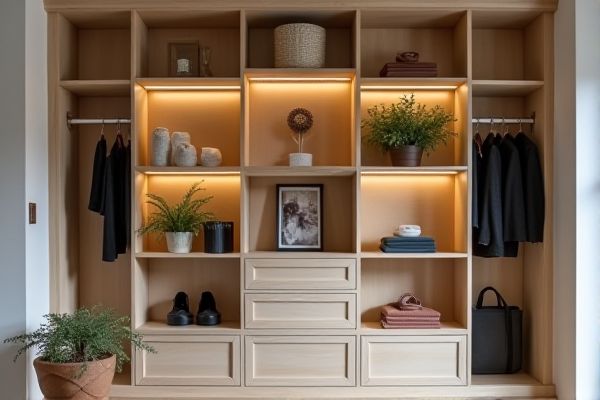
Glass display cabinets protect your belongings from dust while showcasing them in an elegant, organized manner that enhances your closet's aesthetic. Explore the rest of the article to discover which option best suits Your storage needs and style preferences.
Table of Comparison
| Feature | Glass Display Cabinet | Open Shelf (in Closet) |
|---|---|---|
| Visibility | Clear view of items while protected | Full visibility, no barriers |
| Protection | Guards against dust, dirt, and damage | No protection, items exposed |
| Maintenance | Requires regular glass cleaning | Easy to clean, but items may need frequent dusting |
| Aesthetic Appeal | Elegant, showcases collectibles and decor | Simple, functional storage solution |
| Cost | Generally higher price due to materials | More affordable and easy to install |
| Durability | Sturdy frame with fragile glass panels | Durable depending on material, no glass |
| Use Case | Ideal for displaying valuable or decorative items | Best for frequently accessed everyday items |
Introduction: Glass Display Cabinet vs Open Shelf
Glass display cabinets provide a protective, dust-free environment ideal for showcasing delicate items, while open shelves offer easy access and a more casual, airy aesthetic in closet organization. Glass cabinets enhance visibility with transparent panels, making them suitable for displaying collectibles or fine clothing without exposure to dust. Open shelves maximize accessibility and ventilation, supporting quick retrieval and flexible storage for everyday items.
Aesthetic Appeal and Design Differences
Glass display cabinets offer a sleek, modern aesthetic by showcasing items behind clear panes, creating a sense of depth and sophistication, whereas open shelves provide a more casual and accessible look. The reflective surfaces of glass enhance light distribution, making spaces appear brighter and more spacious, contrasting with the matte finish of open shelves that emphasize texture and material variety. Design-wise, glass cabinets typically feature framed, enclosed structures that protect contents from dust, while open shelves prioritize openness and ease of access, impacting both visual clutter and room ambiance.
Space Utilization and Storage Capacity
Glass display cabinets maximize your closet's space utilization by providing enclosed storage that protects items from dust while maintaining visibility, allowing for organized and aesthetically pleasing arrangements. In contrast, open shelves offer more flexible storage capacity and easier access but may lead to clutter and underutilization of vertical space without proper organization. Choosing between the two depends on balancing your need for protection, display, and efficient use of storage volume.
Protection from Dust and Environmental Factors
Glass display cabinets provide superior protection from dust, moisture, and environmental pollutants by enclosing items in a sealed space, preserving their cleanliness and condition. Open shelves expose belongings to airborne particles and humidity, increasing the risk of damage, discoloration, and the need for frequent cleaning. For valuable or delicate items, glass cabinets ensure enhanced preservation compared to open shelving in closets.
Accessibility and Ease of Use
Glass display cabinets provide controlled accessibility by protecting items from dust while allowing clear visibility, making them ideal for delicate or valuable belongings. Open shelves offer immediate and effortless access, enhancing convenience for frequently used items but exposing contents to dust and clutter. Selecting between the two depends on balancing the need for protection with quick and easy access in closet organization.
Organization and Display Options
Glass display cabinets offer a sophisticated way to organize and showcase items, providing visibility while protecting belongings from dust and damage. Open shelves in closets allow easy access and flexible storage configurations but require meticulous arrangement to avoid a cluttered appearance. Choosing between these options depends on balancing protection and aesthetic presentation with convenience and accessibility.
Maintenance and Cleaning Requirements
Glass display cabinets require regular cleaning with non-abrasive glass cleaners to maintain clarity and prevent smudges, while also needing dust removal inside to protect displayed items. Open shelves accumulate dust more quickly and need frequent wiping down to prevent dirt buildup on exposed surfaces and stored items. Both storage options demand consistent upkeep, but glass cabinets offer an added layer of protection against dust and grime, reducing overall cleaning frequency for the contents.
Customization and Versatility
Glass display cabinets offer superior customization options with adjustable shelves, integrated lighting, and lockable doors, enhancing both visibility and security for delicate items. Open shelves provide versatile storage adaptable to various item sizes and easy access but lack protective features, making them better suited for frequently used belongings. Both options cater to different organizational needs, with glass cabinets emphasizing display and protection, while open shelves prioritize flexibility and convenience.
Safety Considerations
Glass display cabinets in closets offer enhanced safety by protecting stored items from dust, damage, and accidental contact, reducing the risk of breakage or injury. Open shelves, while providing easy accessibility, expose items to potential hazards such as dust accumulation, falling objects, and increased risk of accidental knocks, especially in homes with children or pets. Choosing glass display cabinets prioritizes both item preservation and user safety through durable, transparent barriers.
Cost Comparison and Value
Glass display cabinets typically cost more than open shelves due to materials and construction complexity, offering enhanced protection and aesthetic appeal. While open shelves are more budget-friendly and provide easy access, glass cabinets add significant value by safeguarding belongings from dust and damage. Choosing between them depends on your priority for cost efficiency versus long-term preservation and visual enhancement in your closet.
 homyna.com
homyna.com